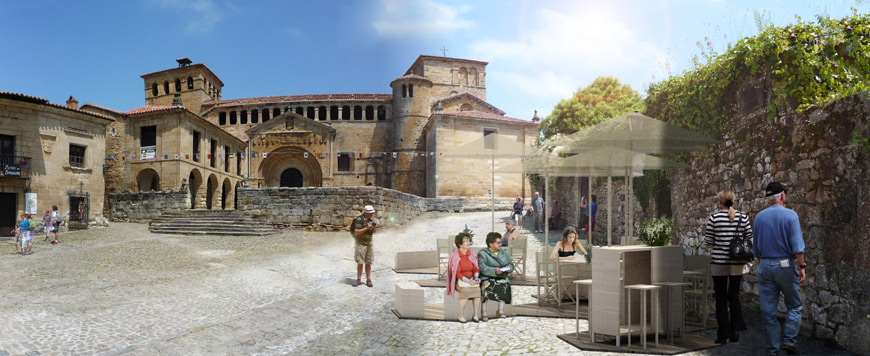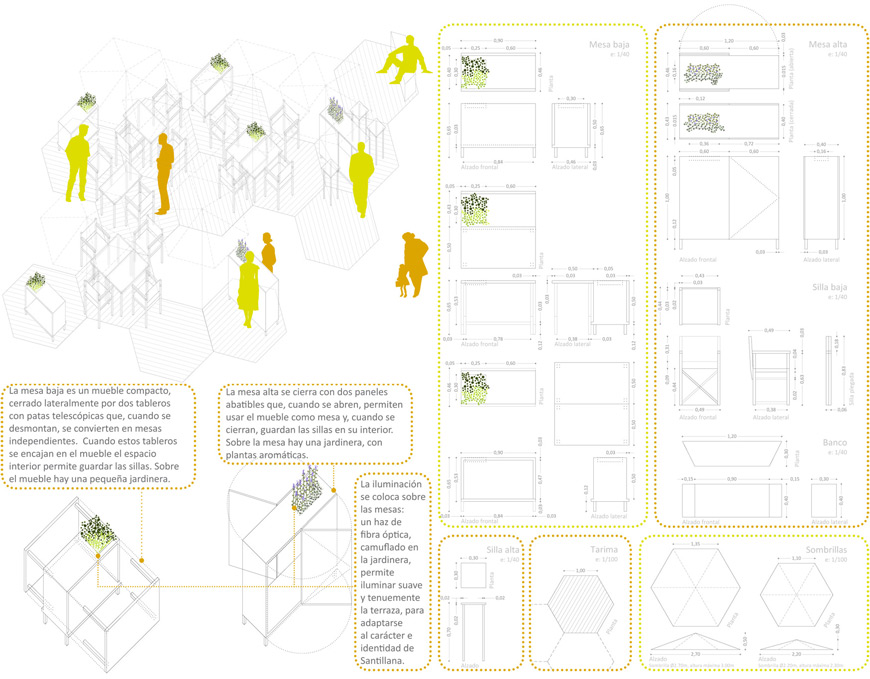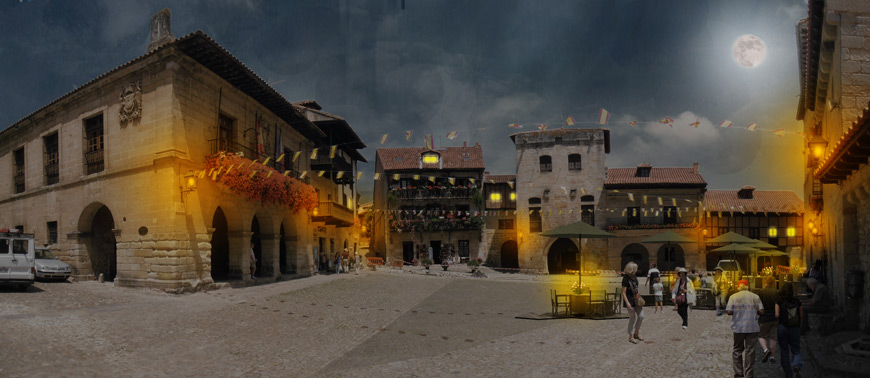management and adaptation of the pavement cafés within the old town of Santillana del Mar. competition
with Lucía Bárcena, landscape architect
location: Santillana del Mar, Cantabria, Spain
year: 2012

Proposal
Santillana del Mar is a charming touristic village in the north of Spain, characterized by quiet streets and stone monuments in a well-preserved medieval atmosphere. The management and adaptation of its public realm as an open living area gives us the chance for a new tourist model that enriches the perception of the aesthetic and formal values of the village. Thus, we seek for a model which can attract new visitors interested in the historical and cultural values which define the character and identity of Santillana del Mar. Accordingly, this evolution from the common massive tourism to another model more focused on the social and cultural elements for attracting long-term visitors approaches Santillana del Mar to a model of Slow City where the hospitality and harmony between inhabitants and tourists are aimed. So that, every intervention in the public realm needs to combine the new uses demanded by the society with a delicate understanding of the historical marks of the village.
Santillana del Mar is a charming touristic village in the north of Spain, characterized by quiet streets and stone monuments in a well-preserved medieval atmosphere. The management and adaptation of its public realm as an open living area gives us the chance for a new tourist model that enriches the perception of the aesthetic and formal values of the village. Thus, we seek for a model which can attract new visitors interested in the historical and cultural values which define the character and identity of Santillana del Mar. Accordingly, this evolution from the common massive tourism to another model more focused on the social and cultural elements for attracting long-term visitors approaches Santillana del Mar to a model of Slow City where the hospitality and harmony between inhabitants and tourists are aimed. So that, every intervention in the public realm needs to combine the new uses demanded by the society with a delicate understanding of the historical marks of the village.
Therefore, our proposal understands the village as an urban landscape, as a complex area where the historical, cultural and social values flourish. In other words, Santillana del Mar is like an open museum whose most important gem is the stone urban fabric where the social relations between their inhabitants take place, as a living area. Considering these values, our pavement café is proposed as a calm intervention in the public realm. Thus, our system is made of hexagonal platforms carpeting the squares, where the furniture of our proposal -tall and short tables, chairs, umbrellas, flower beds and seats- is put on.
This wooden furniture helps to integrate our proposal into the urban landscape, avoiding the colours and shapes which could compete against the heritage and the perception of the place. The stone, which is the most common material in Santillana, engages with ash and earthy colours, as with the beech wood in light tones which we have chosen for our proposal. This furniture is composed by compact and collapsible elements with different uses according to the time of the day: tables and seats can also be used as small cupboards for storing the chairs, tablecloths and cutlery when the café is closed. This idea of artefact-furniture is directly related to the perception and use of the reclaimed public areas by the citizens and the tourists once the economic activity to which it has given ground has stopped.

Flowers and plants
The flower beds of the tall tables are sown with aromatic herbs, such as lavandula angustifolia and salvia farinacea, to give a pleasant aroma when enjoying a conversation and a drink at the pavement café. The colour of their leaves, from the light lemon green of salvia farinacea to the grey green of lavandula angustifolia, and their flowers contrast with the tones of red of the flowers which decorate the balconies of the village.
The flower beds of the tall tables are sown with aromatic herbs, such as lavandula angustifolia and salvia farinacea, to give a pleasant aroma when enjoying a conversation and a drink at the pavement café. The colour of their leaves, from the light lemon green of salvia farinacea to the grey green of lavandula angustifolia, and their flowers contrast with the tones of red of the flowers which decorate the balconies of the village.
The plants for the short tables look completely different: we have decided to use chamaecyparis obtusa, a remarkable conifer with shapes and textures very different from the most common plants in gardening. With that choice we want to create a sensation of visual shade to provide the tables with more intimacy. Its very dense foliage of dark green colours contrasts with the much lighter one with small light green leaves of its partner, angelonia angustifolia, whose flowering occurs in the summertime, when the pavement café is open. Thanks to both foliages and flowers, we get a charming and colorful composition of different shapes and tones which creates an enjoyable place with an outstanding urban background.
 Lighting
LightingBringing new light sources to Santillana del Mar is not an easy task. As we know, the village has a very particular identity wrapped by a traditional and rural atmosphere. Owing to that, it seems to us odd to light the cafés with contemporary street lamps of an excessive white and cold light.
Instead, we have chosen a warm light to improve the perception of the environmental, artistic, ethnographic and landscape values of the place. Thus, in our proposal, the lighting system of the cafés is composed by a bundle of optical fibre, hidden among the plants of the flower bed, which scatters small dots of warm light among the flowers and leaves. As if they were candles or torches, this warm lighting offers a sense of intimacy and quietness which enriches the qualities of the scenery.
Adaptation of the proposal to the historical character of the village
The project sites have different characters: the first site (1) is a commercial and pedestrian area with crafts and gift shops delimited by Santo Domingo, La Carrera and Juan Infante streets. At the other end, it is placed the Palacio de Caja Cantabria, an old house transformed into art gallery. By contrast, both the second site (2) at Plaza Mayor and the third site (3) at the foot of the Collegiate Church have more cultural, touristic and social activity. Although there are still some small shops around them, they are mainly open areas for meeting and holding public activities.
The project sites have different characters: the first site (1) is a commercial and pedestrian area with crafts and gift shops delimited by Santo Domingo, La Carrera and Juan Infante streets. At the other end, it is placed the Palacio de Caja Cantabria, an old house transformed into art gallery. By contrast, both the second site (2) at Plaza Mayor and the third site (3) at the foot of the Collegiate Church have more cultural, touristic and social activity. Although there are still some small shops around them, they are mainly open areas for meeting and holding public activities.
Since the three project sites are very different in shape and character, our pavement café needs a flexible construction system which can be adapted to fit the new uses and requirements regardless the different conditions of the sites. Accordingly, our idea is made of hexagonal wooden platforms that can be easily assembled on irregular plots and adapted to the cultural background and scenery for enhancing the identity and values of Santillana.

